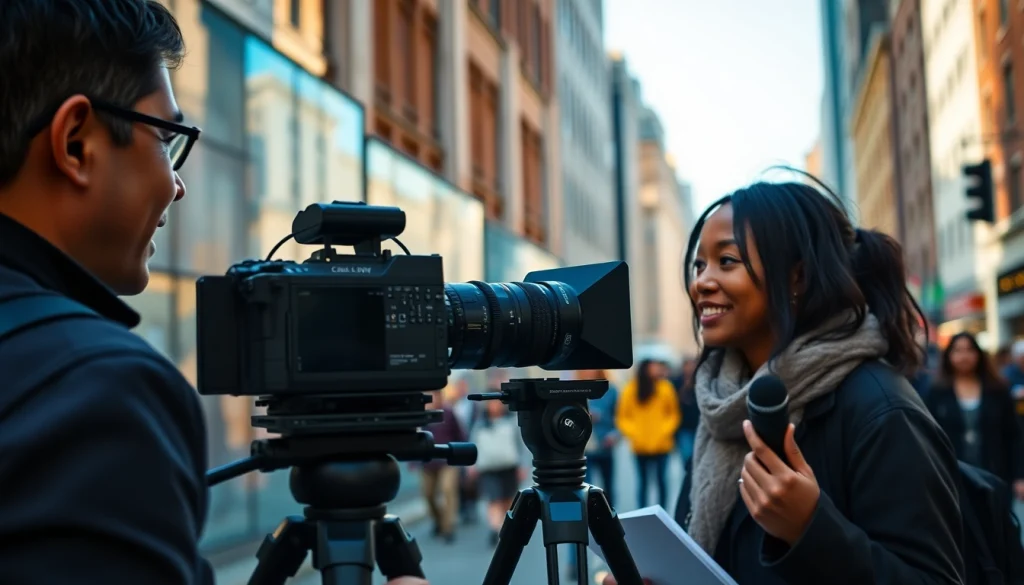Understanding Stories & Documentaries
The world of Stories & Documentaries is both rich and profound, offering insights into the human condition and serving as a mirror to society. In this era where information is abundant yet often fleeting, documentaries provide a grounded perspective, weaving narratives that inform, educate, and inspire audiences around the globe. This article delves into the multifaceted nature of stories and documentaries, exploring their definition, significance, and evolution in the filmmaking landscape.
What Defines a Documentary Story
A documentary story can be defined as a factual representation of reality, crafted through a cinematic lens to convey specific themes, emotions, or insights. Unlike traditional storytelling, which often prioritizes fictional narratives, documentaries aim to present genuine human experiences and truths. This genre encompasses a wide range of styles, including observational, expository, participatory, and reflexive documentaries.
At its core, the documentary story strives to educate and evoke empathy. It tackles pressing issues—be it environmental changes, human rights, or cultural phenomena—using real-life events and interviews with individuals directly affected by the subject matter. Through the careful selection of visuals and sound, filmmakers create a unique narrative that resonates with their audience, often prompting critical reflection and dialogue.
Importance of Authentic Storytelling
Authenticity is the lifeblood of compelling documentary storytelling. Audiences today possess a keen sense for genuine narratives; they crave stories that reflect the complexities of life rather than sugar-coated versions of reality. Authentic storytelling in documentaries is integral for various reasons:
- Building Trust: Authenticity fosters trust between the filmmaker and the audience. When viewers recognize that they are engaging with a truthful representation, they are more likely to connect emotionally with the material.
- Encouraging Change: Documentaries that focus on real issues often motivate viewers to take action. By showcasing authentic experiences, filmmakers can galvanize support for causes, influencing public opinion and promoting societal change.
- Enhancing Relatability: When stories are rooted in authenticity, they resonate more deeply with audiences. This connection can lead to increased engagement and discussion, as people share their thoughts and experiences relating to what they have seen.
The Evolution of Documentaries
The documentary genre has evolved significantly since its inception in the early 20th century. Originally, documentaries were primarily educational tools designed to inform audiences about various subjects such as nature, war, and social issues. Over time, advancements in technology and changes in cultural consumption habits reshaped documentaries into diverse formats.
Currently, the rise of streaming platforms has revolutionized access to documentaries, allowing filmmakers to reach global audiences with relative ease. This democratization of storytelling has also led to an increase in independent documentaries, where fresh voices explore underrepresented narratives and challenge traditional storytelling conventions.
The documentary format has expanded far beyond its conventional boundaries, integrating hybrid forms that blend elements of fiction and non-fiction. As storytelling techniques continue to evolve, so too will the possibilities for documenting the human experience, offering audiences a broader range of perspectives.
Key Techniques in Documentary Filmmaking
Crafting a Compelling Narrative
A compelling narrative is paramount in documentary filmmaking. It anchors the audience’s attention and propels the story forward. Filmmakers often engage in extensive pre-production research to identify the core narrative and themes of their documentary. This involves:
- Identifying a Unique Angle: Exploring familiar subjects from a fresh perspective can make for a more engaging story. For instance, while many documentaries cover social justice issues, a filmmaker might choose to focus on personal narratives from underestimated communities to provide a unique approach.
- Structuring the Narrative: Traditional storytelling techniques, including a clear beginning, middle, and end, can apply to documentaries as well. By outlining the progression of the story, filmmakers can create emotional arcs that captivate viewers.
- Incorporating Visual Storytelling: Visual cues can significantly enhance a narrative. Cinematic techniques, such as establishing shots, close-ups, and creative transitions, enrich the storytelling experience and provide additional context to the narrative.
Utilizing Visual and Audio Elements
The fusion of visual and audio elements plays a crucial role in documentary filmmaking. While visuals convey the factual and emotional undertones of the narrative, audio enhances audience engagement, setting the tone and rhythm of the story. Here are several techniques filmmakers utilize:
- Visual Composition: Thoughtful framing and composition can highlight significant aspects of the story. For example, using the rule of thirds can guide audience attention to critical subjects or actions, enhancing overall comprehension.
- Sound Design: The use of ambient sound, music, and voice-over narration can deepen emotional impact. A well-placed soundtrack can underscore dramatic moments, while ambient sounds provide a sense of realism, transporting viewers into the documentary’s world.
- Editing Techniques: The editing process allows filmmakers to craft a rhythm and flow that keeps viewers engaged. Techniques such as cross-cutting, montages, and juxtaposition of contrasting scenes can create tension and maintain audience interest throughout the narrative.
Strategies for Engaging Interviews
Interviews are often a cornerstone of documentaries, providing firsthand accounts and perspectives. Conducting engaging interviews requires a delicate balance of preparation and spontaneity:
- Creating a Comfortable Environment: Establishing rapport with interviewees can result in more relaxed and authentic responses. Filmmakers should encourage a conversational atmosphere, allowing interviewees to share their stories naturally.
- Effective Questioning: Open-ended questions allow interviewees to elaborate on their experiences, providing richer content. Following up on interesting points that arise organically can result in unexpected insights and engaging moments.
- Active Listening: Paying attention to interviewees’ responses encourages deeper revelations. Filmmakers should be prepared to deviate from their script if the conversation takes an insightful turn, capturing raw emotion and genuine reflection.
Analyzing Successful Stories & Documentaries
Case Studies of Impactful Documentaries
By examining compelling case studies, we can understand the elements that contribute to a documentary’s success. Notable examples include:
- “13th” by Ava DuVernay: This documentary explores the intersection of race, justice, and mass incarceration in the United States. Through a mix of archival footage and contemporary interviews, it challenges societal perceptions of race and offers critical insights into systemic issues.
- “Won’t You Be My Neighbor?” by Morgan Neville: This documentary offers an intimate look at Fred Rogers, the beloved host of “Mister Rogers’ Neighborhood.” Through interviews, archival footage, and personal anecdotes, it illustrates the impact of kindness and empathy, showcasing poignant moments from Rogers’ life that continue to resonate.
- “Jiro Dreams of Sushi” by David Gelb: Through the lens of a sushi master, this documentary delves into the pursuit of perfection in culinary arts. The compelling visuals and intimate interviews provide viewers with insights into dedication and artistry, leaving a lasting impact on the audience.
Lessons from Leading Filmmakers
Successful documentary filmmakers often share common principles that guide their creative processes. We can glean valuable lessons from their experiences:
- Stay Passionate: Filmmakers who are genuinely passionate about their subject matter tend to create engaging and impactful documentaries. This enthusiasm propels the storytelling, leaving a compelling mark on audiences.
- Embrace Vulnerability: Many leading documentary filmmakers make their own vulnerabilities part of their storytelling. By sharing personal experiences and challenges, they create a relatable narrative that resonates more deeply with viewers.
- Be Open to Change: Documentaries can shift directions as new insights arise. Skilled filmmakers embrace adaptability, pivoting their narratives or focus based on the unfolding story, which often leads to richer outcomes.
Audience Reactions and Critical Reception
Documentaries often initiate strong reactions from audiences, which can vary widely based on personal experiences and cultural contexts. Understanding these reactions is crucial for gauging a documentary’s impact:
- Emotional Responses: Documentaries that effectively convey authentic stories often elicit emotional responses ranging from empathy to anger. Filmmakers can capitalize on these sentiments to foster conversations and promote awareness around specific issues.
- Critical Acclaim: Critical reception can significantly influence a documentary’s success. Winning awards or receiving accolades can enhance visibility and attract a wider audience, validating the work’s importance within the film industry.
- Community Engagement: Documentaries that drive cultural conversations often lead to community organizing and advocacy efforts. Engaging with viewers post-screening can enhance understanding and mobilization around key issues highlighted within the film.
The Role of Technology in Documentaries
Innovative Filming Techniques
The landscape of documentary filmmaking has transformed dramatically with advancements in technology. Innovative techniques have emerged that enhance storytelling, including:
- Drone Footage: The use of drones has expanded the visual possibilities for documenting geographical expanses and providing breathtaking aerial views. This technique enriches storytelling by offering perspectives that were once difficult to capture.
- 360-Degree Video: Immersive technology allows for a more engaging viewer experience, placing them directly in the context of the documentary. This format helps convey powerful experiences, particularly in issues focused on human rights and environmental challenges.
- Mobile Filmmaking: As smartphone technology continues to advance, many filmmakers are using mobile devices to capture high-quality footage. This accessibility empowers more individuals to share stories often overlooked in mainstream media.
The Impact of Streaming Platforms
The rise of streaming platforms has fundamentally changed the way documentaries are created, distributed, and consumed. Key impacts include:
- Broader Audience Reach: Documentaries are no longer restricted to traditional broadcasting channels. Platforms like Netflix and Amazon Prime allow independent filmmakers to reach massive audiences, fostering a diverse array of content.
- Increased Production Value: As streaming platforms invest in original documentaries, there is a growing drive for high production quality. Filmmakers can access better resources, technology, and promotion, elevating overall standards in the industry.
- Diverse Narratives: Streaming services have cracked open doors for underrepresented stories and marginalized voices. This shift promotes a richer tapestry of documentary narratives, connecting global audiences to experiences that resonate across cultural lines.
Future Trends in Documentary Filmmaking
The future of documentary filmmaking is poised for exciting developments. Emerging trends include:
- Increased Use of Interactive Formats: As technology evolves, the integration of interactive elements in documentaries is likely to become more prevalent. Viewers may engage with content through apps or online platforms, enhancing immersion.
- Focus on Short-Form Content: With the rise of platforms like TikTok and Instagram, short documentaries that quickly convey impactful messages will gain traction. These formats will cater to younger audiences accustomed to digesting content rapidly.
- Sustainability in Filmmaking: A growing awareness of environmental issues will inspire filmmakers to adopt eco-friendly practices in production. This includes choosing sustainable materials, reducing waste, and promoting awareness around ecological topics in their documentaries.
How to Create Your Own Stories & Documentaries
Pre-Production Planning Essentials
Creating a documentary involves extensive preparation. Effective pre-production planning includes:
- Research and Development: Thorough research helps filmmakers shape their narratives. This includes understanding cultural contexts, identifying potential interviewees, and recognizing existing literature on the subject matter.
- Script Development: While documentaries often embrace spontaneous storytelling, drafting a script helps ensure that essential points are covered. This acts as a blueprint during shooting while allowing room for improvisation.
- Budgeting: Budgeting for a documentary encompasses equipment costs, travel expenses, and post-production. Clear financial planning helps manage resources effectively, ensuring the project remains on track.
Filming and Editing Tips for Beginners
Filming and editing are critical elements of producing a documentary, and beginners can adopt specific strategies to improve their skills:
- Invest in Quality Equipment: While budget constraints may limit equipment options, investing in reliable gear will enhance production value. This includes cameras, microphones, and lighting kits.
- Practice Composition Techniques: Learning framing rules and shot composition can elevate footage quality. Filmmakers should experiment with different angles and sounds to discover their unique visual style.
- Embrace the Editing Process: Editing allows filmmakers to refine their narrative. Beginners should familiarize themselves with editing software to combine visuals and audio elements effectively, enhancing the overall storytelling.
Distributing Your Documentary Effectively
Distribution is the final, crucial phase of documentary filmmaking. Effective strategies include:
- Leveraging Film Festivals: Submitting documentaries to film festivals can provide valuable screening opportunities and networking options. Film festivals can also validate the work and attract potential distributors.
- Utilizing Social Media: Create a robust online presence to generate buzz and audience interest leading up to the documentary’s release. Social media platforms can facilitate audience engagement and conversations.
- Consider Streaming Platforms: With numerous streaming platforms eager for diverse content, filmmakers should explore these options for wider distribution beyond traditional channels. This includes pitching to networks and leveraging online tools for independent distribution.








